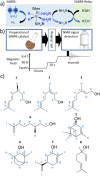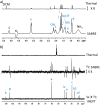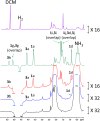Enhancing the NMR signals of plant oil components using hyperpolarisation relayed via proton exchange
- PMID: 37736655
- PMCID: PMC10510812
- DOI: 10.1039/d3sc03078d
Enhancing the NMR signals of plant oil components using hyperpolarisation relayed via proton exchange
Abstract
In this work, the limited sensitivity of magnetic resonance is addressed by using the hyperpolarisation method relayed signal amplification by reversible exchange (SABRE-Relay) to transfer latent magnetism from para-hydrogen, a readily isolated spin isomer of hydrogen gas, to components of key plant oils such as citronellol, geraniol, and nerol. This is achieved via relayed polarisation transfer in which an [Ir(H)2(IMes)(NH2R)3]Cl type complex produces hyperpolarised NH2R free in solution, before labile proton exchange between the hyperpolarisation carrier (NH2R) and the OH-containing plant oil component generates enhanced NMR signals for the latter. Consequently, up to ca. 200-fold 1H (0.65% 1H polarisation) and 800-fold 13C NMR signal enhancements (0.65% 13C polarisation) are recorded for these essential oils in seconds. Remarkably, the resulting NMR signals are not only diagnostic, but prove to propagate over large spin systems via a suitable coupling network. A route to optimise the enhancement process by varying the identity of the carrier NH2R, and its concentration is demonstrated. In order to prove utility, these pilot measurements are extended to study a much wider range of plant-derived molecules including rhodinol, verbenol, (1R)-endo-(+)-fenchyl alcohol, (-)-carveol, and linalool. Further measurements are then described which demonstrate citronellol and geraniol can be detected in an off-the-shelf healthcare product rose geranium oil at concentrations of just a few tens of μM in single scan 1H NMR measurements, which are not visible in comparable thermally polarised NMR experiments. This work therefore presents a significant expansion of the types of molecules amenable to hyperpolarisation using para-hydrogen and illustrates a real-world application in the diagnostic detection of low concentration analytes in mixtures.
This journal is © The Royal Society of Chemistry.
Conflict of interest statement
There are no conflicts to declare.
Figures






Similar articles
-
Quantification of hyperpolarisation efficiency in SABRE and SABRE-Relay enhanced NMR spectroscopy.Phys Chem Chem Phys. 2018 Nov 7;20(41):26362-26371. doi: 10.1039/c8cp05473h. Epub 2018 Oct 10. Phys Chem Chem Phys. 2018. PMID: 30303501 Free PMC article.
-
Hyperpolarisation of Mirfentanil by SABRE in the Presence of Heroin.Chemphyschem. 2021 Jun 4;22(11):1059-1064. doi: 10.1002/cphc.202100165. Epub 2021 May 11. Chemphyschem. 2021. PMID: 33871116
-
Direct and indirect hyperpolarisation of amines using parahydrogen.Chem Sci. 2018 Mar 9;9(15):3677-3684. doi: 10.1039/c8sc00526e. eCollection 2018 Apr 21. Chem Sci. 2018. PMID: 29780498 Free PMC article.
-
Advancing homogeneous catalysis for parahydrogen-derived hyperpolarisation and its NMR applications.Chem Sci. 2022 Mar 22;13(17):4670-4696. doi: 10.1039/d2sc00737a. eCollection 2022 May 4. Chem Sci. 2022. PMID: 35655870 Free PMC article. Review.
-
SABRE: Chemical kinetics and spin dynamics of the formation of hyperpolarization.Prog Nucl Magn Reson Spectrosc. 2019 Oct-Dec;114-115:33-70. doi: 10.1016/j.pnmrs.2019.05.005. Epub 2019 May 25. Prog Nucl Magn Reson Spectrosc. 2019. PMID: 31779885 Review.
Cited by
-
Unconventional Parahydrogen-Induced Hyperpolarization Effects in Chemistry and Catalysis: From Photoreactions to Enzymes.ACS Catal. 2025 Apr 4;15(8):6386-6409. doi: 10.1021/acscatal.4c07870. eCollection 2025 Apr 18. ACS Catal. 2025. PMID: 40270879 Free PMC article. Review.
References
-
- Angelovski G. Tickner B. J. Wang G. Nat. Chem. 2023:1–9. - PubMed
LinkOut - more resources
Full Text Sources

